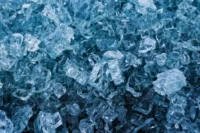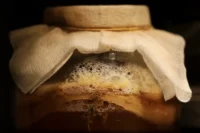
Going Outdoors During Winter – Here’s What You Need
Going Outdoors During Winter offers a unique and invigorating experience, allowing you to enjoy the serene beauty of snow-covered landscapes and the crisp, fresh air.
In the world of cooking and crafting, there’s a versatile and unassuming tool that often gets overlooked: cheese cloth. While its name might suggest it’s solely for cheese-making, this lightweight fabric has another impressive trick up its sleeve – it’s an absolute game-changer when it comes to straining liquids. In this article, we’ll explore why cheese cloth is your secret weapon for mess-free straining, and we’ll delve into some practical uses. So, let’s unravel the magic of cheese cloth for straining liquids!
First things first, what makes cheese cloth such a star in the straining department? The answer lies in its unique properties:
1. Fine Weave: Cheese cloth is woven with a fine mesh that allows liquids to pass through while trapping solids. This means you can strain liquids without worrying about bits and pieces making their way into your final product.
2. Breathability: Unlike many other straining materials, cheese cloth is breathable. This means liquids pass through it easily, making straining a breeze and preventing the cloth from clogging.
3. Versatility: Whether you’re straining stocks, soups, sauces, or infusions, cheese cloth is up for the task. Its versatility makes it a kitchen essential.
Let’s break down how to achieve mess-free straining with cheese cloth in a few simple steps:
Step 1: Prepare Your Cheese Cloth Cut a piece of cheese cloth large enough to cover your strainer or container. It’s better to have a little extra cloth than not enough.
Step 2: Set Up Your Straining Station Place your strainer or container over a clean bowl or pot to catch the strained liquid. If you’re using a strainer, make sure it fits securely over the container.
Step 3: Position the Cheese Cloth Drape the cheese cloth over the strainer or place it inside the container, leaving some overhang to secure it later.
Step 4: Pour and Strain Carefully pour the liquid you want to strain through the cheese cloth. The fine mesh will catch any solids, leaving you with a clear liquid in the container below.
Step 5: Gather and Squeeze (Optional) If you have a lot of liquid to strain, you can gather the corners of the cheese cloth, creating a pouch. Gently squeeze to extract every drop of liquid.
Step 6: Dispose of Solids Once you’ve strained the liquid to your satisfaction, gather the cheese cloth with the trapped solids inside and discard them. Cheese cloth is disposable, making cleanup a breeze.
Now that you know how to achieve mess-free straining with cheese cloth, let’s explore some practical applications:
1. Homemade Broths and Stocks: Strain homemade broths and stocks to remove bones, herbs, and other solids, leaving you with a clear, flavorful liquid base for soups and sauces.
2. Clarifying Butter: If you’re a fan of clarified butter (ghee), cheese cloth is your best friend. Strain melted butter through it to remove milk solids, resulting in a pure, golden liquid.
3. Infused Oils: When infusing oils with herbs, spices, or aromatics, use cheese cloth to strain out the flavorings, leaving you with a beautifully flavored oil.
4. Fruit and Vegetable Juices: Make fresh fruit or vegetable juices without worrying about seeds and pulp. Cheese cloth will strain out the unwanted bits, leaving you with pure juice.
5. Preserves and Jellies: When making preserves or jellies, use cheese cloth to strain the fruit mixture, ensuring a smooth and clear final product.
Now that you’re eager to start your mess-free straining adventures with cheese cloth, you might wonder where to find it. One excellent source for high-quality 100% organic cotton cheese cloth designed specifically for culinary and straining purposes is GoodToHave, your trusted online shop for food preservation and self-sufficient living.

Going Outdoors During Winter offers a unique and invigorating experience, allowing you to enjoy the serene beauty of snow-covered landscapes and the crisp, fresh air.

In the world of food preservation, Mylar bags have become increasingly popular due to their durability and ability to protect food from environmental factors. While

Fermentation, an ancient method of food preservation and flavor enhancement, has experienced a resurgence in popularity in recent years. From tangy sauerkraut to fizzy kombucha,